Cycle the Mayan Kingdom
This article first appeared in the March 2012 issue of Adventure Cyclist magazine.
If there was ever a good reason to pack your bags and go bike touring before the end of this year, it might it be this: the world is ending. According to apocalyptic storytellers, our planet’s destruction is scheduled for December 21, 2012, to coincide with the end-date in the Mayan Long Count calendar. Even if you don’t buy into this doomsday prophecy, it’s high time to hurry south to the rough-cut gem of Guatemala. While you’re there, be sure to check in on its neighbor, the rugged Mexican state of Chiapas. Once part of the same great Mayan kingdom, these two regions share an undeniable natural beauty, intricate architectural structures, and similarly rich indigenous culture. Miles upon miles of low-traffic roads and an abundance of off-road options make for nearly endless adventurous and affordable cycle touring. The caveat? Be sure your gears are in good working order because I can promise you’ll be needing them.
As even seasoned travelers sometimes do, I landed in heaving, chaotic Guatemala City and promptly paid an inflated gringo price for a direct bus to calm and colonial Antigua. In an effort to get my bike-tour legs under me, I purposefully selected an uber-budget hostel, only to be assaulted by an army of ravenous bedbugs sometime after midnight. Thankfully, my riding partner Cass Gilbert arrived the next morning to scoop me out of my culture-shock daze and catapult us on one of his typically demanding cycling adventures. But, before our wheels could get rolling, I had to get some actual wheels. Along his journey south from Alaska, Cass had enthusiastically tapped in to local bike culture whenever possible. In Guatemala he connected with MayaPedal, a non-profit organization that not only renovates donated bikes to sell back to the community but also dreams up bicycle-inspired machinery — bicimachinas — to assist off-the-grid households. The coolest example by far is the Bicilicuadora, a pedal-powered smoothie maker, ideal for the country’s incredibly cheap and healthy tropical fruit — piles of vibrant mangos, papayas, bananas, tomatoes, and avocados garnish tables at every town market.
Arriving at the MayaPedal workshop in the ramshackle mountain town of San Andres de Iztapa, I was awestruck by the sight of hundreds of bicycles, dozens of oily parts buckets, walls of well-used tools, a bank of homemade workbenches, and a handful of eccentric volunteers tinkering away like Santa’s little elves. During his time here, Elf Cass had uncovered a very special steed from among a pile of cheap Huffys: a circa 1996 Mongoose steel-framed mountain bike. It was simple, durable, in good condition, and the perfect size for me.
An avid cyclist, I normally won’t leave home without my bike. But the Mongoose’s $100 asking price handily beat the cost of a round-trip airline ticket for my trusty companion. Plus buying locally meant that I’d be riding a steed that could be easily repaired at any of the hole-in-the-wall cycle shops peppered throughout Guatemala’s hills. Eager to test my new wheels, Cass and I packed panniers, loaded up, and took off on a shake-down ride in the mighty volcanic hills behind MayaPedal. As ever, I was thrown in at the deep end. Cass’s morning loop began with, and sustained, one of the steepest climbs my legs had ever pedaled. Thankfully, my new little Mongoose behaved impeccably, and its modest cost seemed more in keeping with our humble surroundings. Guatemalans toiling in rambling cornfields stopped to wave and shout encouraging words as we slowly but surely progressed uphill.
Maybe Cass selected this particular ride because he knew that it would give me a good feel for what was in store for us. More likely, knowing Cass, his penchant for riding off the beaten track meant riding where there’s barely a track at all. In any case, it was a smart move because that morning climb calibrated my expectations and prompted me to pare weight from my luggage and fit a bigger cassette to the bike. With a month to explore the Mayan kingdom, our plan was to make a clockwise loop through Guatemala and southern Mexico on quiet back roads, passing through remote indigenous villages and taking on the mountains in our path.
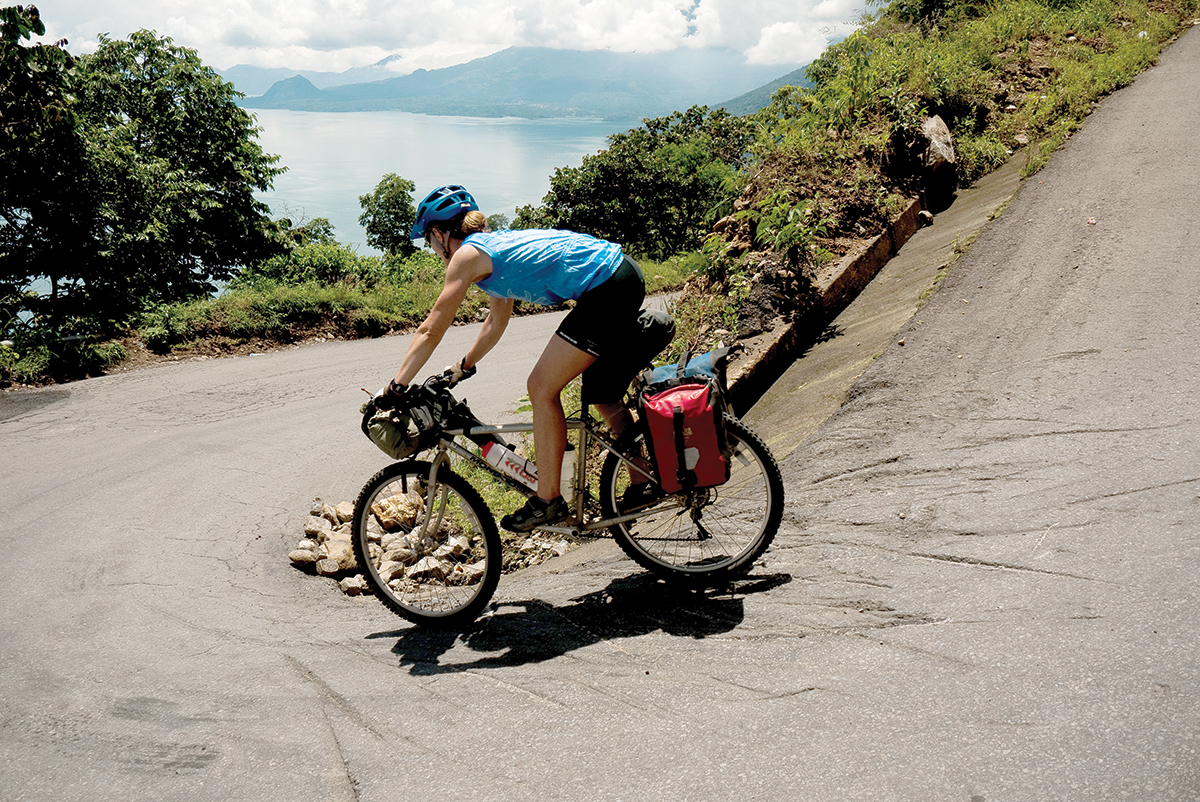
I did mention this part of the world was hilly, didn’t I? To get a sense of the torturous terrain, think of a piece of green construction paper crumpled tightly in a ball, then stretched out slightly to form a west-east band. That’s the profile of the Guatemalan highlands — all ups and downs in impossibly steep relief. Crossing north into Mexico’s Chiapas, it’s like the paper’s edges stretch outward to reveal wider valleys and softer climbs. Circling east into the Guatemalan lowlands of Petén, the sun’s constant heat is like a flatiron, leveling and scorching the area into dusty submission. Continuing south back to San Andres de Iztapa, the humidity returns and Mother Earth crinkles the paper once again, forming push-inducing vertical climbs among volcanic mounds and lush jungle. Mayan culture is as varied as this terrain with over 25 different tribes in Guatemala and Chiapas, each speaking a different dialect. Picking up on the variations in color and style of women’s dress — women wear traditional clothes more often than men — is an easy way to identify transitions into new tribal areas.
As if the hills weren’t enough, shortly after departing MayaPedal and skirting around the stunning volcanically formed Lago Atitlán, we realized we were in the eye of hurricane season. A freezing, incessant, and remarkably punctual deluge burst from the sky daily at 2:00 PM, washing away roads, crops, and our hopes of riding some of the less hard-packed tracks. Yet it was too early in the tour to give up the scheme of riding the “back route” from San Pedro to Quetzaltenango (helpfully nicknamed “Xela”). So after 60 hard miles in three long days — carrying our bikes over landslides, forging through snake- infested jungles, and pushing for hours up the steepest climbs imaginable — we reached Xela momentarily triumphant. We subsequently resolved to take an easier route north into Mexico rather than repeat (quite so soon) a neck-tensing, back-breaking, pushing ordeal on the Guatemalan side of the border.
Crossing into Mexico, I couldn’t help wondering why the Guatemalan roads were so ridiculously steep. When traveling abroad, I’m always amazed by what people think is or is not rideable and generally possible. Historically, Mayans had certainly not shied from a challenge. They were known for innovating calendar systems and developing the first written pre-Columbian language. They also built complex and spectacular temples that remain the visible legacy of the Mayan civilizations which spanned thousands of years before the Spanish conquest in the 16th century. Guatemala also embodies the impossible. Fragility and inequality are part of its shadow and light composition, especially evident during its 36 years of civil war (1960-1996), which forced many people under the poverty line. People continue to fight for passage to a better life in the U.S. Over 10 percent of Guatemala’s GDP comes from money remitted back from migrants hard at work in the States. Were the short, painfully sharp roads symptomatic of a lack of resources? In time, would economic progress spur the construction of easier roads with longer but shallower inclines? Or were the iconic chicken buses — lavishly repainted ex-U.S. school buses enjoying second lives in the fast lane thanks to supercharged diesel engines and fearless drivers — the Guatemalan answer to extreme terrain? It’s not surprising that pushing up silly-steep roads gives you time to ponder such questions.
As for the question of what was and was not rideable, we were beginning to get a feel for the local barometer. To fine-tune our route, we exhaustively canvassed each and every person we met. Some folks seemed to take a conservative and protective approach, assuming our bikes and gangly selves were not up to much snuff. This view partly reflected people’s own experiences with bikes — the home-grown models were not made for bone-shaking downhills and gravity-defying climbs. Then there was the other sort of person. The hearty, cowboy-boot-wearing, teeth missing, farmer/road worker/rickshaw driver who — after giving our steeds the once over — had an intrinsic belief that our same gangly selves were invincible. So when the crooked old man with a solitary tooth promised, despite the swarm of frowning naysayers encircling Cass at the ramshackle taxi stand in Ocosingo, that “Si, hay paso” — the road was passable — what did we do?
We rode on.
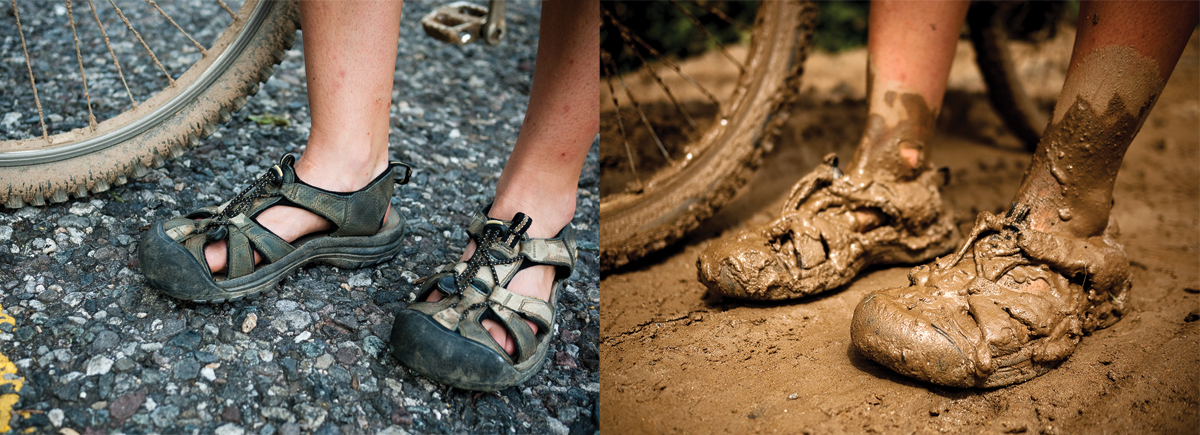
We allowed the breakfast delights of the bustling Ocosingo mercado — fresh papaya licuados and piping hot tortillas with beans — to delay us only briefly before riding into uncertain territory ahead. Outside the prosperous town boundaries, a different scene began to unfold. Chiapas is one of Mexico’s richest states in terms of raw resources — including gas, oil, corn, and coffee — yet similar to Guatemala, indigenous communities had been systematically neglected and lacked access to basic services and opportunities. In this environment, a leftist people’s movement took root, inspired by Ernesto “Che” Guevara, then given a voice by Subcommandante Marcos. Calling themselves the Zapatistas, the group hit international news in 1994 when they led a gutsy protest against Mexico’s signing of NAFTA. As we cycled past junctions, bus stops, and cafes in Chiapas, we noticed the enduring political banners, spirited murals, and ideological signs rallying people to stand up against unrepresentative government. Meanwhile, a few lingering encampments were conspicuous reminders of the Mexican army’s swift response to the Zapatista uprising.
But the current atmosphere was calm, reconciled, and, despite the intermittent pockets of kids yelling “Gringo!!,” the Zapatista heartland was friendly and welcoming for tourists. In fact we encountered kindness from a stranger that very night. The day’s riding hadn’t been too strenuous, but the route was longer than it seemed on the map and darkness was rapidly closing in. As we stood at the roadside wondering if we’d make the next village before nightfall, the only vehicle we’d seen all day pulled to a stop beside us. Waving, smiling, and calling out in perfect English, Emidgo invited us to his home in the next village, Monte Líbano. The fact that he wasn’t even going to be there didn’t seem to be an issue — he promised his wife would be just as happy to take us in. Indeed, we had a wonderful evening eating, conversing, and finally sleeping on the roof of their family home, surrounded by silent stars and rustling jungle foliage. Muchisimas gracias, Emidgo.
The next day we woke early, mentally and physically prepared to tackle a massive climb and cycle into the unknown. Our map gave up on detail right around Monte Líbano. It had a vague dotted path leading up to blue lakes at Laguna Naja and a weak squiggle onward to Sibal. Still, we felt confident in our solitary-toothed muse and began climbing on an empty dirt track into the Lacandon jungle, where the last direct descendants of the ancient Mayans purportedly reside. Isolated and conservative as they are, the Lacandon tribe would be impossible to miss in their ankle-length white robes and untamed, uncut, black locks. The climb proved shorter and easier than expected so we decided to enjoy a leisurely lakeside picnic lunch. But mosquito swarms and thick jungle foiled this plan. By chance, the alternative — plastic chairs outside a tiny, sparsely stocked shop — proved a great place to admire the simple gowns and flowing hair of the Lacandon men passing by. We didn’t linger for long, knowing the remainder of the ride could be a toughie. The landslide -— which had reduced traffic to nothing — could prove totally impassable for us too. Even as we cycled through the last village before the slide, people were shaking their heads and muttering about impossible conditions.
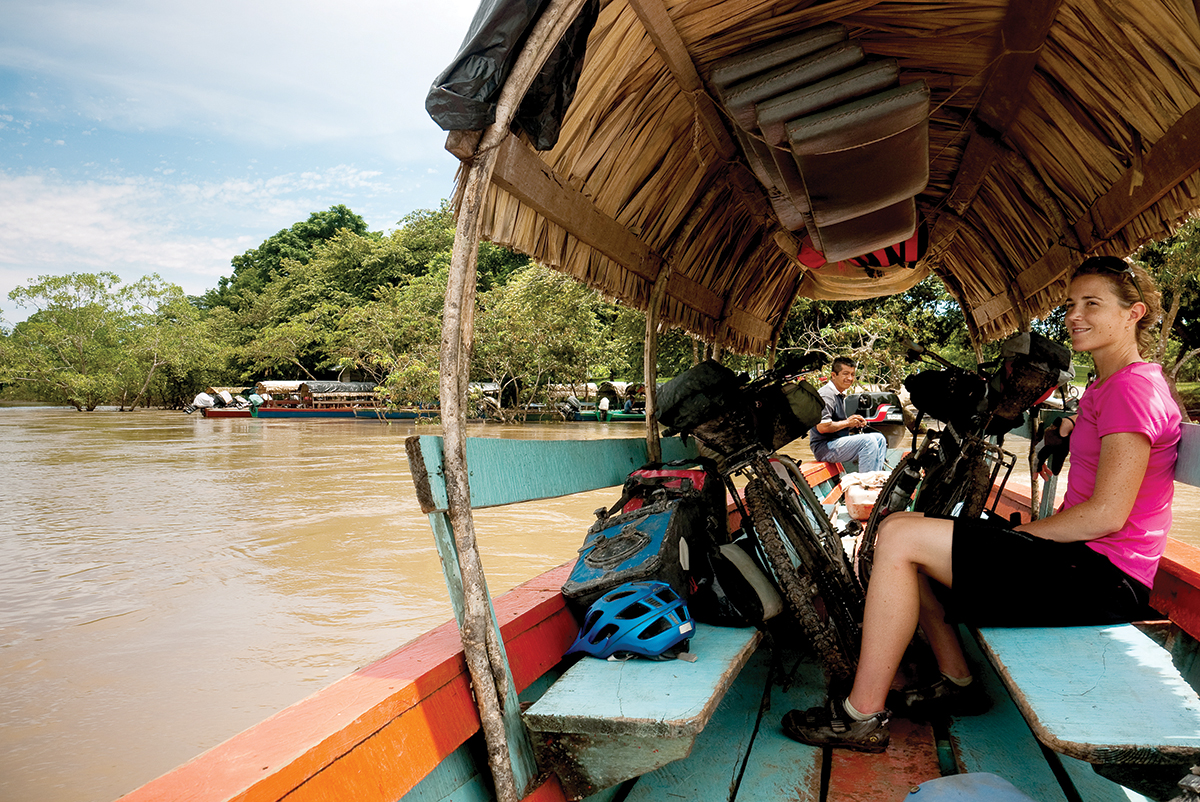
Undeterred, we rode on. After all the anxious anticipation, when we finally reached the loose, muddy slope piled high on top of the road, it seemed relatively harmless. Lifting bikes onto our shoulders, we clambered two feet up, slid one foot down, then over and over until reaching the top, much to the amazement of the crowd of onlookers. That molehill surmounted, we made speedy progress along new pavement all the way to Bonapak, our last stop in Mexico. That night, we endured one final bone-soaking, camera-destroying, campsite-flooding, sudden deluge.
The next day, we bobbed across the Usumacinta River in a rickety boat, and almost immediately after re-entering Guatemala, the daily rains gave way to searing heat and the smooth tarmac crumbled into dusty, bumpy track. For the next 100 sweaty miles, we couldn’t possibly take in enough water, ice cream, licuados, and Agua de Jamaica (thirst-quenching juice made from water and hibiscus flowers), guiltily buying out dozens of small shops along the way from Bethel to Flores.
Now at the halfway point in our loop, feeling parched and exhausted, we decided it was time for a short break. El Petén region was the perfect place to rejuvenate. For a week, we concentrated on little more than swimming and sunning at pristine Lake Petén Itzá, gorging on delicious organic food at Finca Isabel in Poptun and detouring to the backpacker paradise at the wondrous limestone bridge near Semuc Champey. We also explored the temples and pyramids of one of the most notable ancient Mayan cities — Tikal — built up over a period of more than 1,000 years. Each of these sights truly deserved the guidebook hype, and our tired cycling legs certainly appreciated the well-timed respite. As expected, as soon as we crossed into the rugged coffee-covered hills of the Alta Verapaz, the challenging climbs and cool stormy weather began to crank up.
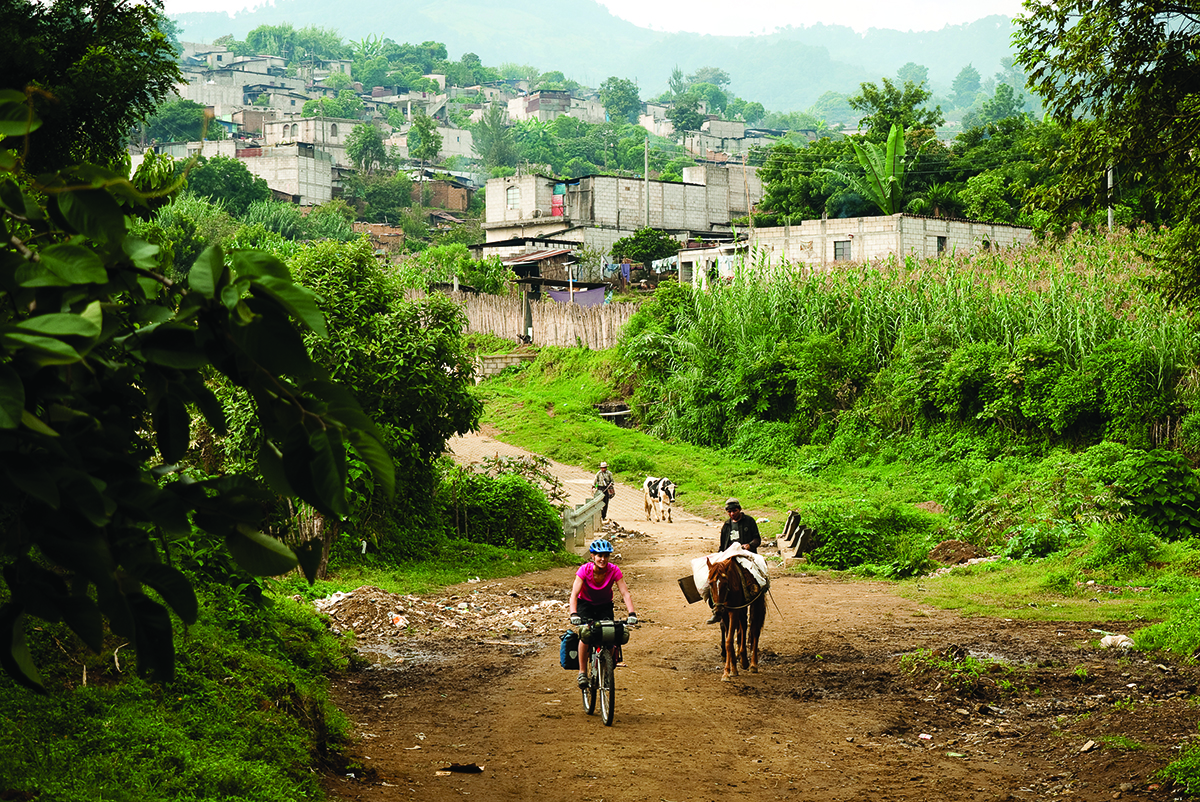
It’s not that we sought the most demanding routes possible, but it didn’t take long riding with fast, belching traffic outside Coban — a bustling and rapidly growing coffee town — before we hunted for a detour from the main drag. We took a chance turn onto a perfectly empty stony track which led us through deep river crossings and over huge summits before rejoining the main road miles later. Buoyed by this lucky find, we couldn’t resist the temptation of unraveling one last mystery. Would the thin line on our map over Tres Cruces prove to be a passable — or impossible — apex to the off-road finale back south to San Andres de Iztapa?
We cycled enthusiastically through a few villages until we reached the last, seemingly dead-end town and “decision” junction. When we inquired about the faint track disappearing into the sheer face of the mountain ahead of us, we received a string of negative responses, heads shaking adamantly. As luck would have it, at the last minute two cyclists — local guys out for a weekend spin — rolled up to the junction.
Us: Was there a road to Tres Cruces and beyond? Them: Yes, but it’s steep!
Figuring we were well acquainted with steep, we rode on. After a deceptively straightforward beginning led us farther uphill than the point of no return, we fell into a familiar pattern of pushing, and pushing, and pushing for hours. At least our pushing muscles were well honed from many previous steeper-than-steep roads, and our minds were attuned to the rhythm of footfalls instead of pedal strokes. The handful of people we passed along the track shook their heads in disbelief, but they reinforced with a casual wave of the hand that Tres Cruces was “just over there.”
With darkness falling and the summit still nowhere in sight, Cass snagged a timely camp spot — the only relatively flat piece of hillside around — and we let our aching muscles rest. On big climbs like this, I think to myself: Be patient for the top and stay focused on where you are; it’s not over until you can go nowhere but down. Early the next day we reached that point, marked by the Tres Cruces cell phone tower, and I felt equal measures of victory and hunger! We scarfed a couple of stale muffins to tide us over until Pachalum, a busy town at the bottom of the climb, where we found what turned out to be the best pizza shop in all of Guatemala. Having spent years working in the U.S. (like so many Guatemalans), the shop owner eagerly chatted with us, practicing his English, while we devoured his delicious thin-crust ham and cheese pies.
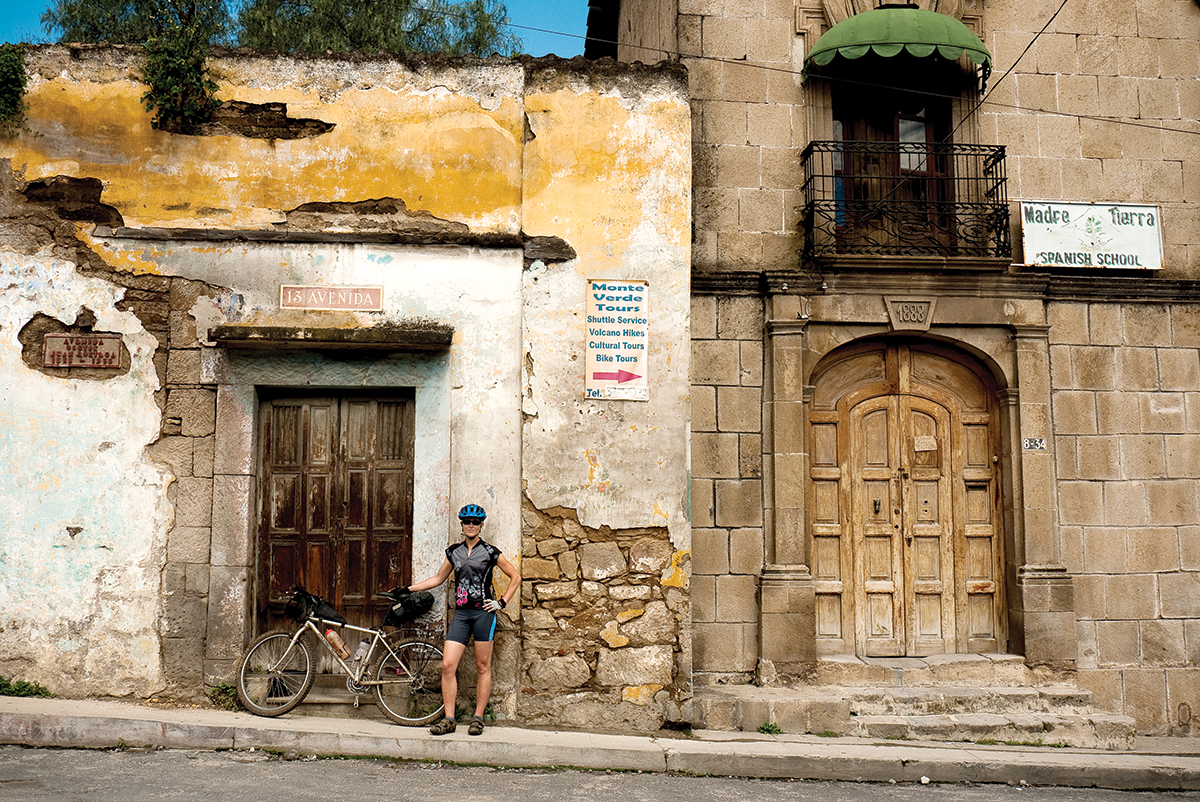
With the final Tres Cruces mystery solved, we unwound our tight and aching muscles on easy but busier roads for the final stint back to San Andres de Iztapa. Battling once more with Guatemala’s congested traffic and speeding chicken buses was a good reminder that our efforts to head into such challenging backcountry had been well worth it. Although I never look forward to the end of a bike tour, I have to admit that the final hill up to MayaPedal came with a sense of relief and satisfaction. My trusty local bike had done me proud! We celebrated our return with one last spin on the bicilicuadora and savored the banana-papaya smoothie that came as our reward. If you’ve got strong legs, a love of fruit and tortillas, and a penchant for riding mountain roads, there is an abundance of route possibilities throughout the Mayan kingdom in Guatemala and Mexico. Just get there soon before time runs out!

